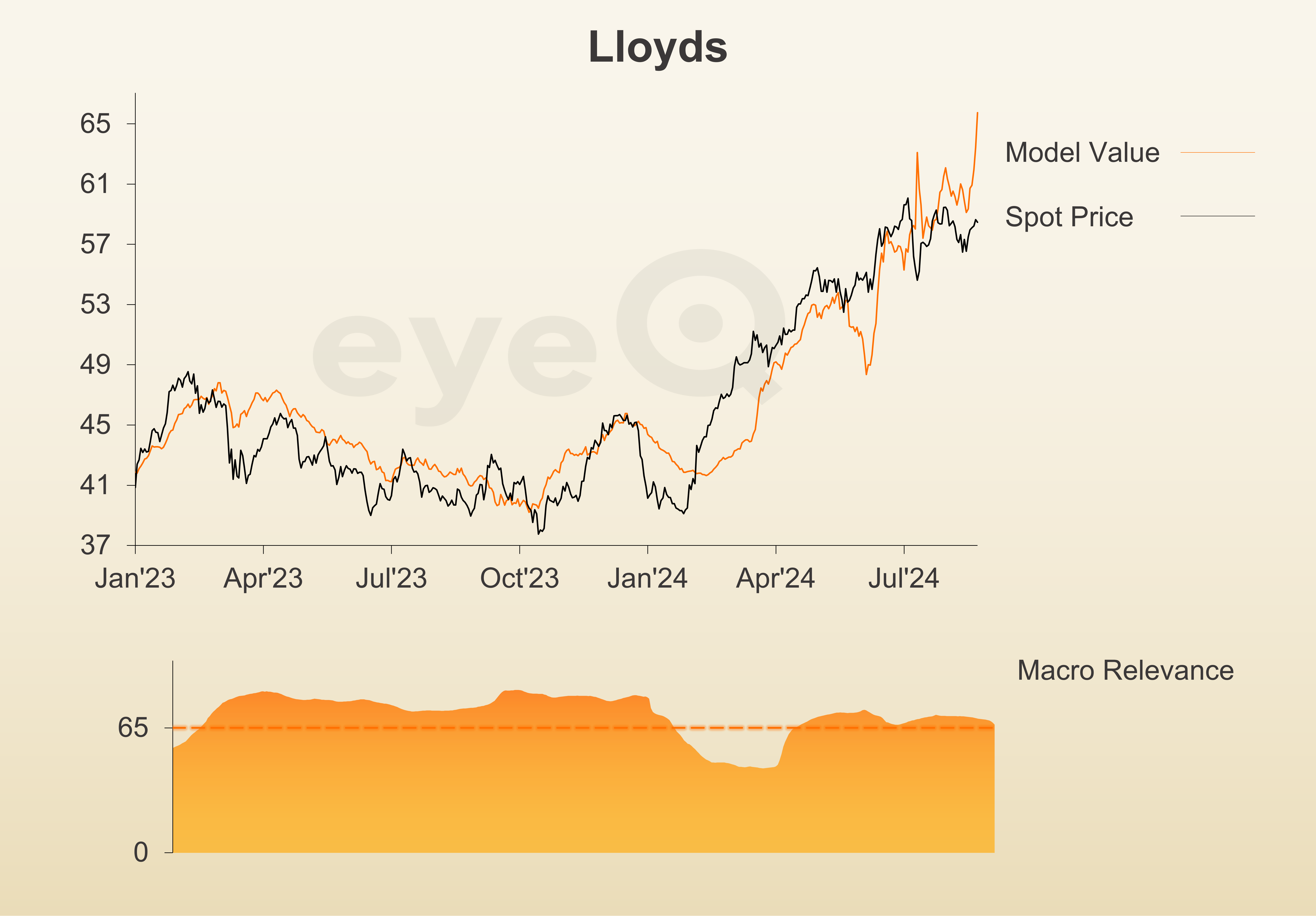eyeQ: why Lloyds Bank shares just triggered a bullish signal
Experts at eyeQ have used AI and their own smart machine to analyse macro conditions and generate actionable trading signals. Now, it’s spotted a big tailwind for UK banking stocks.
18th September 2024 10:37
by Huw Roberts from eyeQ

Lloyds Bank
Macro Relevance: 67%
Model Value: 65.08p
Fair Value Gap: -11.52% discount to model value
Data correct as at 18 September 2024. Please click glossary for explanation of terms. Long-term strategic model.
Dark horse
At the start of August, eyeQ warned that some UK banking stocks - notably NatWest Group (LSE:NWG) and Barclays (LSE:BARC) - had run ahead of macro fundamentals and looked rich on our models. Bank stocks peaked around that time and have moved sideways since.
There is a sense banks are in a consolidation phase awaiting the next trend. One reason for that could be the UK Budget next month – could it include additional taxes for UK lenders? Or it could be a focus on the Bank of England’s rate cuts – will they hurt banks’ Net Interest Margins?
But it is noticeable how eyeQ model value has moved significantly higher in early September for all UK banks. eyeQ macro-warranted model value has hit new highs for Lloyds Banking Group (LSE:LLOY), NatWest and Barclays.
The improvement in macro conditions has been driven by the bond market – specifically low interest rate volatility, and tighter eurozone government spreads. Basically, a well-behaved bond market is proving a big tailwind for UK banking stocks.
Spot share prices are lagging this move so all three screen as cheap to model, although at this stage only Lloyds has actually triggered a bullish signal. It sits 11.52% cheap to prevailing macro conditions.
eyeQ’s smart machine highlights these kinds of dislocations. It is then up to individual investors to decide whether these signals warrant further research, or whether they should be ignored.
In this instance, we would argue a discretionary overlay would decide to wait and watch. The UK Budget and the impact of Bank of England rate cuts we’ve already mentioned. The Federal Reserve’s rate decision tonight and the Bank of Japan’s on Friday are equally consequential for financial markets.
If, this time next week, we’ve moved past those big events and eyeQ model value shows macro conditions still trending higher, and stock prices are still lagging, then we have an opportunity on our hands.

Source: eyeQ. Past performance is not a guide to future performance.
Useful terminology:
Model value
Where our smart machine calculates that any stock market index, single stock or exchange-traded fund (ETF) should be priced (the fair value) given the overall macroeconomic environment.
Model (macro) relevance
How confident we are in the model value. The higher the number the better! Above 65% means the macro environment is critical, so any valuation signals carry strong weight. Below 65%, we deem that something other than macro is driving the price.
Fair Value Gap (FVG)
The difference between our model value (fair value) and where the price currently is. A positive Fair Value Gap means the security is above the model value, which we refer to as “rich”. A negative FVG means that it's cheap. The bigger the FVG, the bigger the dislocation and therefore a better entry level for trades.
Long Term model
This model looks at share prices over the last 12 months, captures the company’s relationship with growth, inflation, currency shifts, central bank policy etc and calculates our key results - model value, model relevance, Fair Value Gap.
These third-party research articles are provided by eyeQ (Quant Insight). interactive investor does not make any representation as to the completeness, accuracy or timeliness of the information provided, nor do we accept any liability for any losses, costs, liabilities or expenses that may arise directly or indirectly from your use of, or reliance on, the information (except where we have acted negligently, fraudulently or in wilful default in relation to the production or distribution of the information).
The value of your investments may go down as well as up. You may not get back all the money that you invest.
Equity research is provided for information purposes only. Neither eyeQ (Quant Insight) nor interactive investor have considered your personal circumstances, and the information provided should not be considered a personal recommendation. If you are in any doubt as to the action you should take, please consult an authorised financial adviser.
Disclosure
We use a combination of fundamental and technical analysis in forming our view as to the valuation and prospects of an investment. Where relevant we have set out those particular matters we think are important in the above article, but further detail can be found here.
Please note that our article on this investment should not be considered to be a regular publication.
Details of all recommendations issued by ii during the previous 12-month period can be found here.
ii adheres to a strict code of conduct. Contributors may hold shares or have other interests in companies included in these portfolios, which could create a conflict of interests. Contributors intending to write about any financial instruments in which they have an interest are required to disclose such interest to ii and in the article itself. ii will at all times consider whether such interest impairs the objectivity of the recommendation.
In addition, individuals involved in the production of investment articles are subject to a personal account dealing restriction, which prevents them from placing a transaction in the specified instrument(s) for a period before and for five working days after such publication. This is to avoid personal interests conflicting with the interests of the recipients of those investment articles.